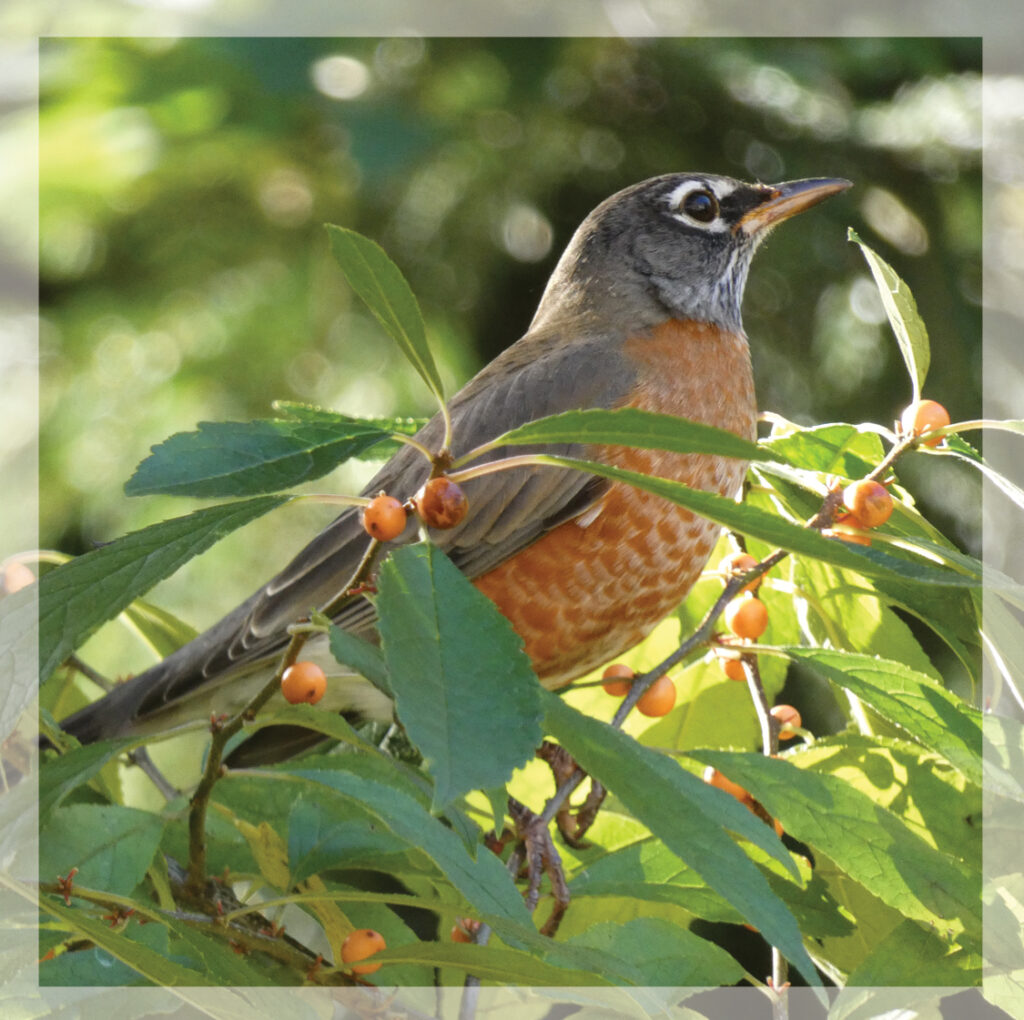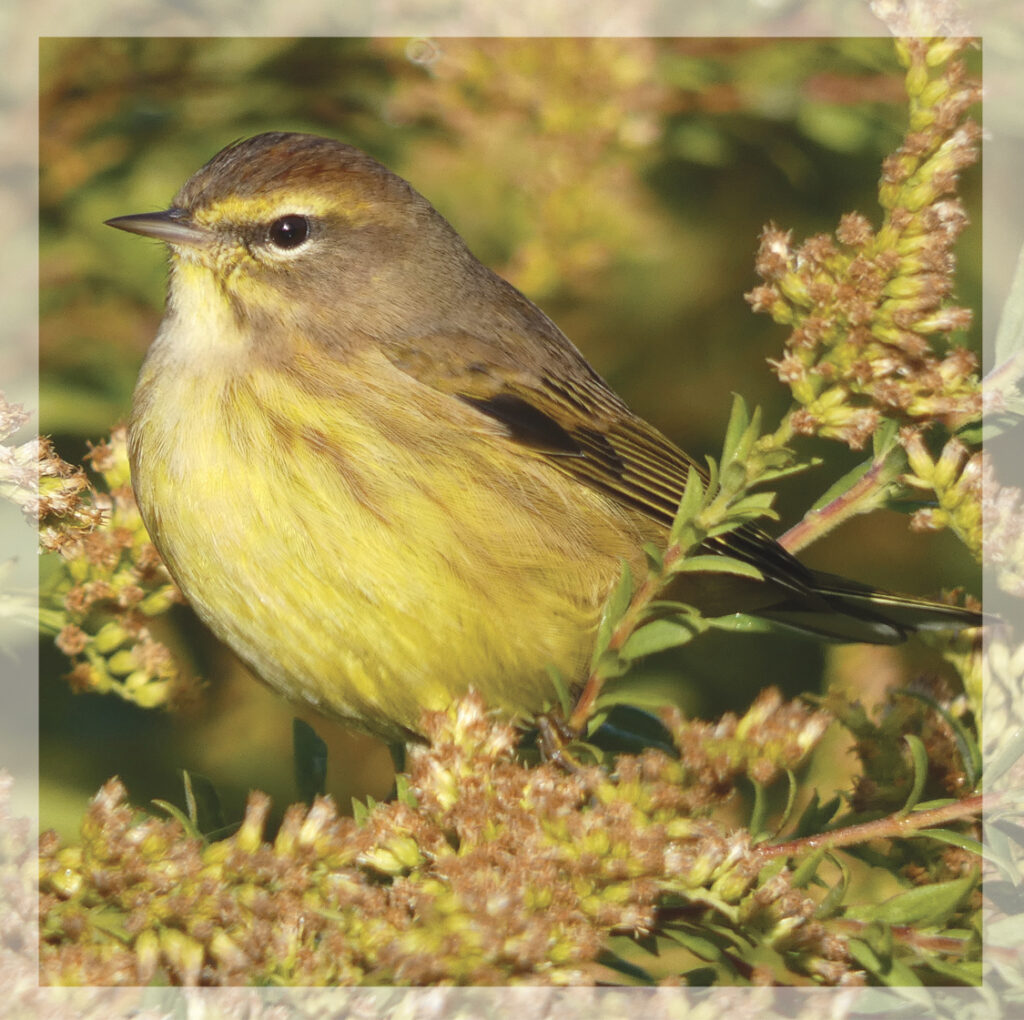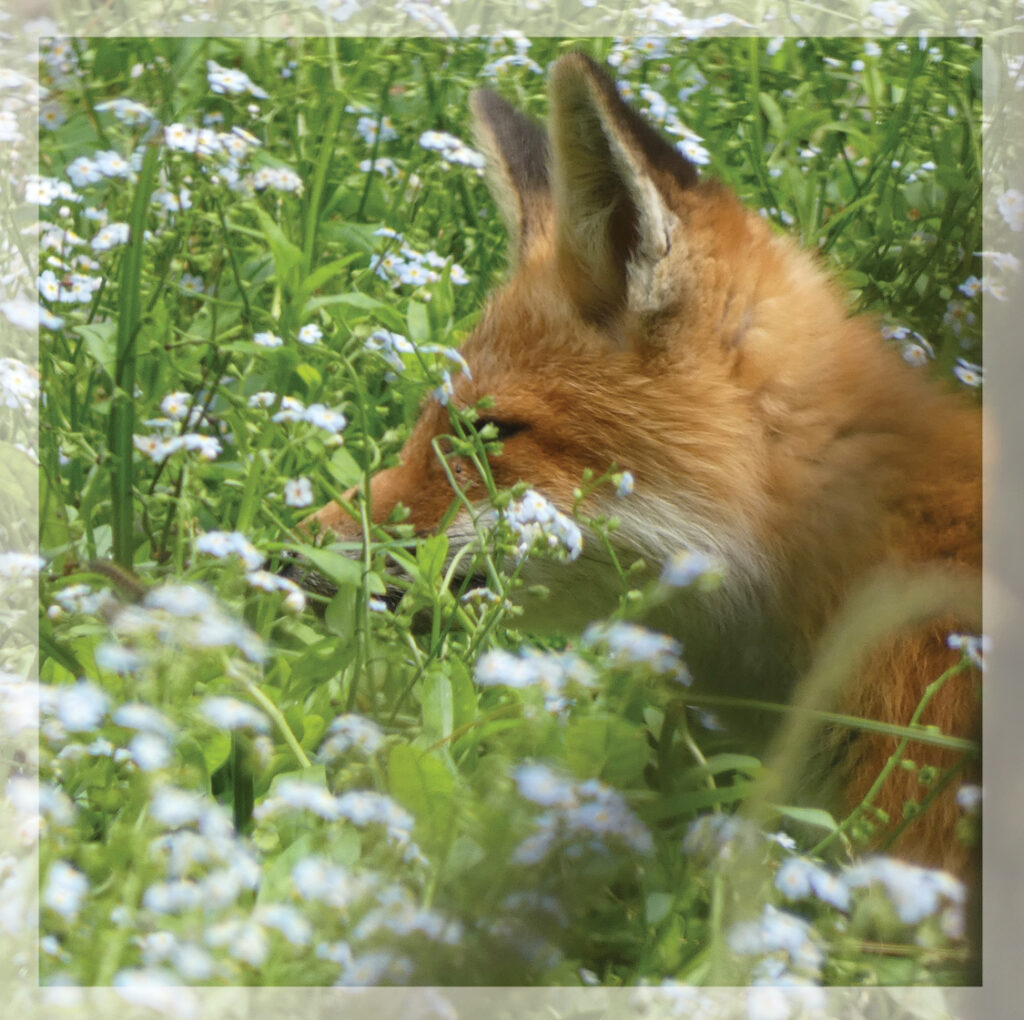Rebecca Heider was featured in the April 2024 Quakers Today podcast.
Eight Lessons for Friends and Seekers
When the Adult Class Committee of my meeting first approached me last year about giving a presentation on my new hobby of bird photography, I balked. ”I’m just a beginner,” I protested. “There are so many people in the meeting who are more experienced birders and better photographers! Besides, what does birding have to do with Quakerism?” The presentation didn’t end up happening that spring. But all summer, every time I was out with my camera looking for birds, I was thinking, What does birding have to do with Quakerism?
As I thought about it more, I found many connections between my new practice of birding and the Quaker practice that has long been part of my life. I realized that as a newcomer to birding, I may not have authority on the topic, but I had the perspective of a seeker: thinking intensely about it and learning along the way. So I find I have something to say about birding and Quakerism after all, which I’ve condensed into eight lessons from birding that can inform our Quaker worship.

Lesson 1: Bald Eagle
I finally found time to explore nature photography during the COVID-19 pandemic. 2020 was my year of insects, when I spent long hours in sunny meadows chasing butterflies; 2021 was my year of mushrooms, poking around in wet leaves on the forest floor. In 2022, I was ready for the year of birds, so I purchased a camera with a telephoto lens. I thought our family trip to Alaska—specifically a day of rafting through a bald eagle preserve—would be the perfect time to launch my career in bird photography.
In fact, that was a foolish and hubristic plan. I could barely operate the camera, and the only halfway-decent photo from that day was this still from a video. I now realize that even a veteran photographer would find it challenging to get a good photo while bobbing over whitewater.
By waiting to begin my journey into bird photography until I had traveled thousands of miles to this one special place on this specific day, I had set myself up for disappointment. And I had missed out on opportunities to get started earlier closer to home. This brings me to my first lesson: If we look to connect with Spirit only in a designated sacred place or on a specific holy day, we limit our opportunities for spiritual transformation.

Lesson 2: Song Sparrow
On the opposite end of the birding spectrum from the bald eagle preserve in Alaska is a site a few miles from my home that I typically pass several times a day: Dixon Meadow Preserve in Lafayette Hill, Pa. Where the Alaska trip was costly in terms of time and money, I could fit a visit to Dixon into my day with no advance planning. Where Alaska was once in a lifetime, Dixon was three times a week.
As birding outings became part of my weekly routine instead of a special event, the pressure to glimpse a rare bird or to capture a stunning photo subsided. Even if there were no birds in sight, I felt nourished and restored by the beauty and peace of the meadow, like a meeting for worship when no vocal ministry is given.
At Dixon, the counterpart to the bald eagle was the song sparrow. On every visit, from a hot summer day to a blustery winter morning, these cheerful birds were there to greet me. Where the bald eagle is huge and majestic, the song sparrow is small, humble, and plain. Song sparrows are also cooperative photo subjects, perching at the tops of trees and singing their hearts out to announce their presence.
Over the course of the year, song sparrows gave me practice with my camera and taught me to appreciate how much beauty and variety there is, even in something ordinary; I’ve been able to capture many photos of song sparrows, each one with its own beauty. My second lesson became this: Practicing connecting with the Divine every day and in ordinary ways prepares us for worship and helps us go deeper.

Lesson 3: Northern Flicker
A transformative moment in my relationship with birds came at an Audubon event where a multi-generational group shared about their “spark birds.” Sitting in a large circle, we spoke out of the silence about the bird that first sparked our interest in birding. It was a powerful experience of sharing our deep emotional connections with nature and with each other, and it had the spirit of a Quaker meeting for worship.
My own spark bird was a northern flicker. I saw this bird with its beautifully patterned plumage in my yard and had no idea what it was. Breathless with excitement, I ran from room to room peering out my windows to get a better view. That night I eagerly reported the encounter to my family.
In the following days, I reflected on the immense and unlooked-for joy that bird brought me. The northern flicker had likely been visiting my yard regularly, but I hadn’t been paying attention before. It was an important lesson to realize the joy I felt that day had been available to me all the time; all I had to do was look for it.
As I began to notice birds, I was also more aware of what the people around me were missing. While I stopped to photograph a red-tailed hawk on Forbidden Drive in the Wissahickon Valley of Philadelphia, a dozen or more people made their way around me on their bicycles, or jogging, or chatting with friends. No one’s gaze followed the direction of my camera to see what I was photographing. How close we are to such transformative encounters every day! And how often we miss them.
Later, after photographing a goldfinch on a stalk of goldenrod, I was approached by a group of birders excited about a rare bird spotted nearby. “Did you see it?” they asked eagerly when they noticed me with my camera. No, this was “just a goldfinch.” It was nothing exciting, but another small miracle. That brings me to lesson three: The Divine is available to us everywhere and all the time. We just need to pay attention.

Lesson 4: American Robin
Once I started to truly pay attention to birds, I realized that familiarity had blinded me to their beauty. What is this lovely bird with its speckled breast tinged with apricot and its distinctive white eye ring? It’s the ubiquitous American robin, which we see so often throughout most of North America that we stop seeing them at all. How can we awaken ourselves to the beauty all around us every day? This robin paused while snacking on winterberries to pose for me.
In the right light, you realize that the humble, dun-colored mourning dove has complex patterns and rosy tones in its soft plumage. I was on my hands and knees under a rhododendron bush to photograph a mushroom one day when I looked up to see a young chickadee perched on the mossy branch right in front of me. Moments later an attentive parent came by to offer him a snack: so ordinary, so beautiful.
Throughout the summer, there is a constant thrum of ruby-throated hummingbirds visiting the feeders on our porch. They are just a whizzing blur in the background, until you stop to really look, which brings me to my fourth lesson: Truly paying attention to the world around us allows us to experience the Divine in the ordinary.

Lesson 4 (part 2): Palm Warbler
As I began to visit Dixon Meadow Preserve three times a week, I became aware of how the population of birds changed over the course of the seasons: which birds were regulars and which were just passing through. The palm warbler was the first migrant bird that I really took an interest in. Stopping by twice a year on their migration, the palm warblers spend a few weeks enjoying the flowering goldenrod. The day I took this picture, I remember asking myself, “Could there be anything more beautiful than these sweet, butter-yellow birds among the goldenrods?”
I only saw an American tree sparrow once, on a winter morning. The orchard oriole was another bird that was only in town for a few weeks in the spring. This brings me to the second part of lesson four: Truly paying attention to the world around us allows us to experience the Divine in the ordinary and also in the extraordinary.

Lesson 5: Indigo Bunting
I usually appreciate the serendipity of crossing paths with a particular bird, but I really wanted a good photo of an indigo bunting. These beautiful birds always looked blurry or malformed in the photos I took. Over time, I learned to recognize their call, and I knew what section of the meadow they frequented and at what time of day. Finally, all of this preparation paid off when I captured my favorite photo of the summer. This experience informed lesson five: Preparation through study and practice will help us find the rich experience of worship that we are seeking.

Lesson 6: Hooded Warbler
Most of the hours I spend birding, I am alone. But one of the highlights of the summer was when veteran birder friends came to visit me in the Poconos. Birding with them, I noticed how much richer our experience was because we each contributed something. I knew the area and was able to lead them to likely spots. My younger ears could pick out birdsong before they heard it. And they had a wealth of experience and knowledge to share that guided us in spotting and identifying birds.
The hooded warbler was one of the more uncommon birds I photographed that summer. When I took this photograph, I was alone, but I wouldn’t have been able to take it without everything I learned from the shared experience of birding with friends. This reminds me of a question I reflect upon often: if Quakers believe there is a direct connection between an individual and God, why is it important for us to worship in community? Lesson six offers one answer to this question: Worshiping in community broadens our experience of the Divine by drawing on diverse gifts and perspectives.

Lesson 7: Red-Winged Blackbird
Over the year, I learned that in order to capture interesting photos of birds, you have to adopt their vantage point. Seeing the world through a bird’s eyes, you notice the rhythms of their lives as they migrate, mate, and feed their young. When the red-winged blackbirds returned to Dixon in late winter, the meadow was filled with their raucous mating cries. In the fall, when the meadow was golden with wheat in the morning sunshine, goldfinches fattened themselves up for winter by eating the plentiful seeds and grains. I also observed an osprey feeding fish to its offspring and a tree swallow preparing to defend its nest (top of page, main photo) from an approaching house sparrow.
When we practice a radical empathy with birds, we remind ourselves of how connected we are with all creatures and how much their lives are like our own: filled with joys and challenges. At the same time, this inspires humility. There is so much more going on in the world than only our human concerns. This brings me to lesson seven: Experiencing the Divine involves cultivating radical empathy to connect with something greater than ourselves.

Lesson 8: A Fox in Forget-Me-Nots
I always have to remind myself not to be so focused on birds that I miss other miracles. One afternoon, I followed the call of a great crested flycatcher through the dense woods and into a sunny clearing filled with forget-me-nots. As I perched on a mossy log, hoping to glimpse the elusive bird, I noticed that I wasn’t alone. A red fox was silently nosing its way through the flowers nearby. I sat watching, entranced, until it made its way back into the woods. I had gone looking for a bird but instead found the most profoundly peaceful moment of my summer.
How often do we head into Quaker worship looking for an answer to one question, and find instead the answer to a question we didn’t know we had? I’ve noticed a perfectly formed spider web illuminated by sunlight, a mourning cloak butterfly resting on tree bark, and a Halloween pennant dragonfly hanging on to the tip of a branch; these moments lead to the final lesson: When we let go of our preconceptions, we may encounter the Divine in forms we didn’t expect.
Web extra
The author’s extended slideshow on Quakers and birding includes many more photos of birds mentioned in the article.
BirdsForQuakers_revised



Thank you, Rebecca, for your creativity and wisdom in making these connections between birdwatching, Quaker worship, and spiritual renewal. The photos are exquisite and your insights are inspiring.
In one of Ursula Leguin’s books, aliens come to Earth and settle here. The protagonist goes into a curiosity shop – a junk shop, really – run by one of them. He asks the proprietor how the things on sale are chosen. The answer: “What comes is acceptable.”
An excellent motto for travel of any kind, and particularly for birding.
Wonderfu to be able to read this again after having attended the presentation. The photographs are really amazing!
I think I enjoyed this article more than anything else I have ever read in Friends Journal. I love birds, and I appreciate the simplicity with which you have connected birds to the enriching practices of Quakerism.